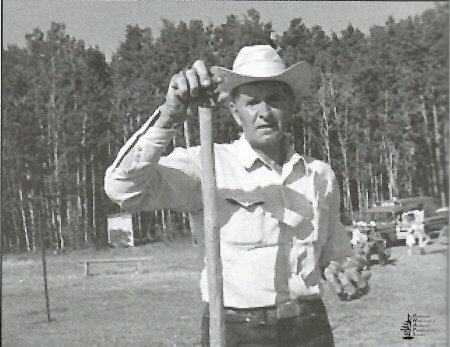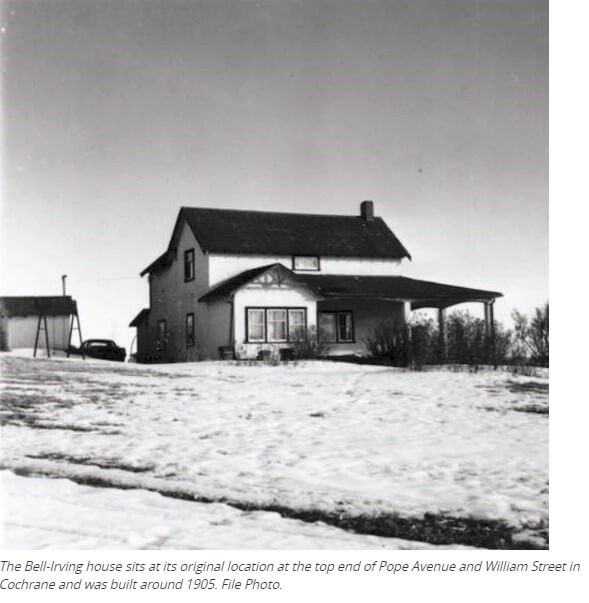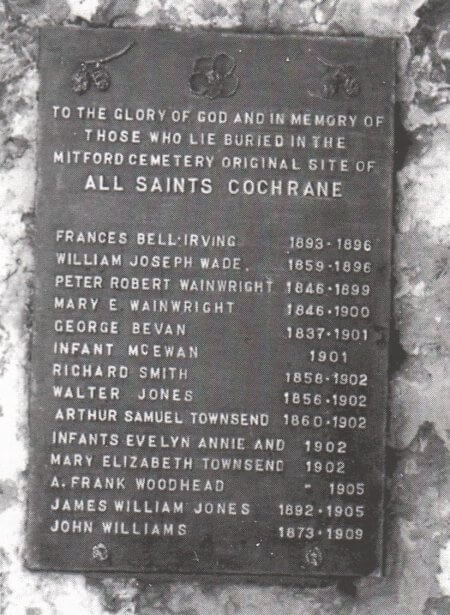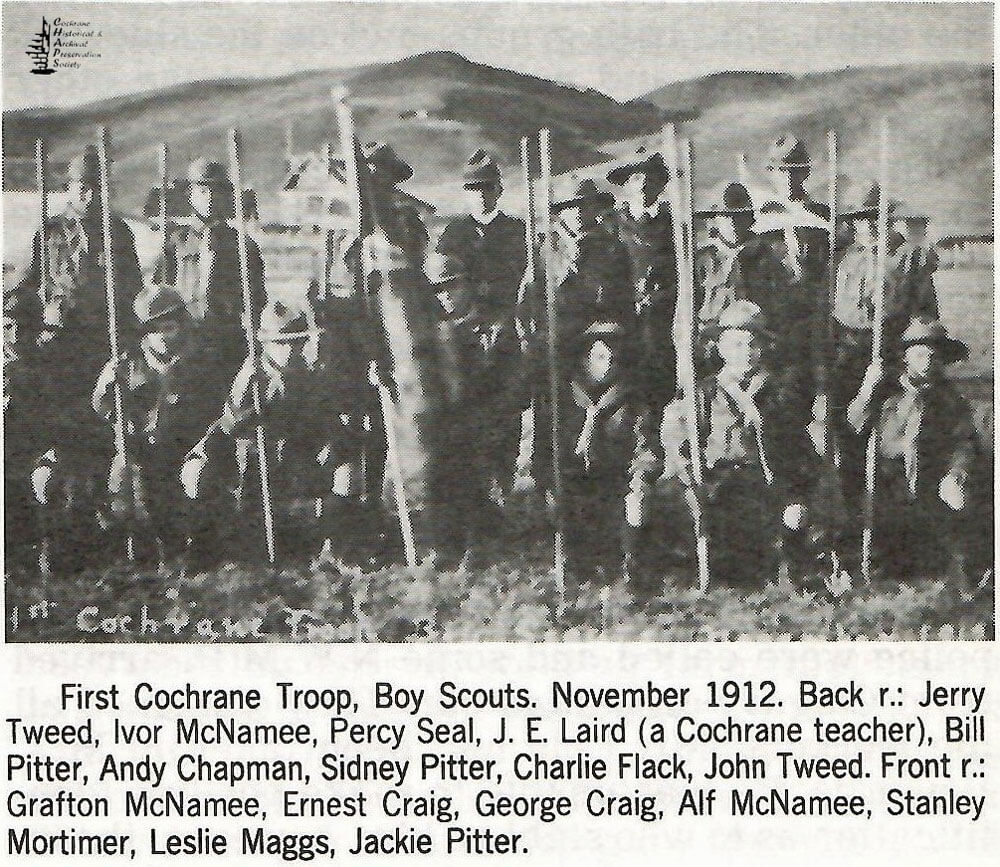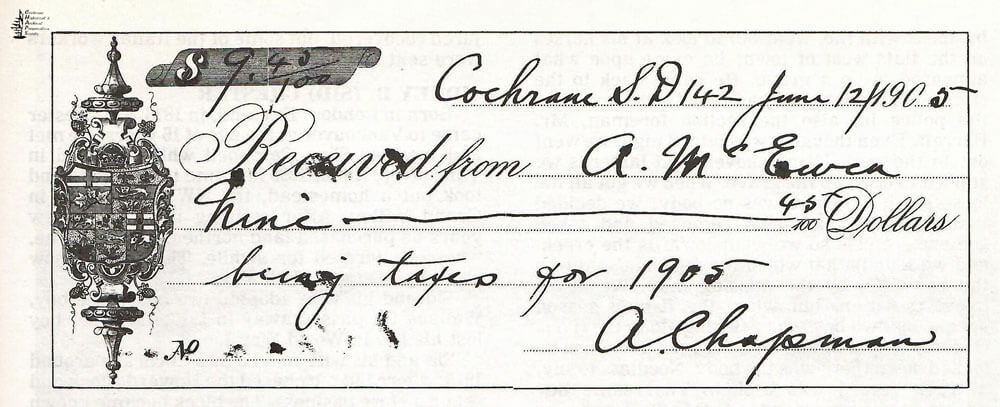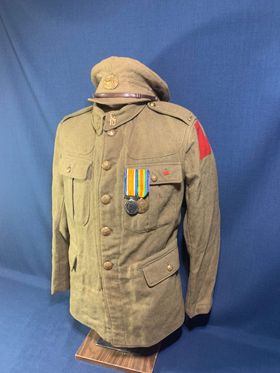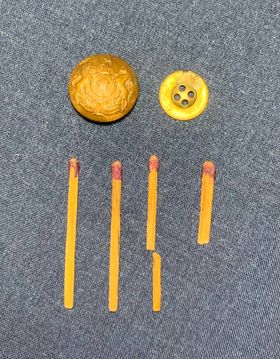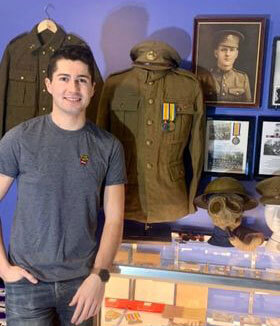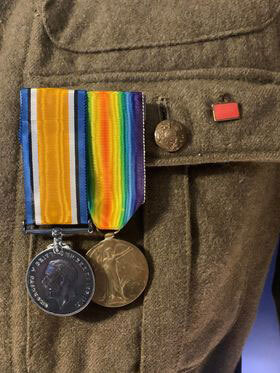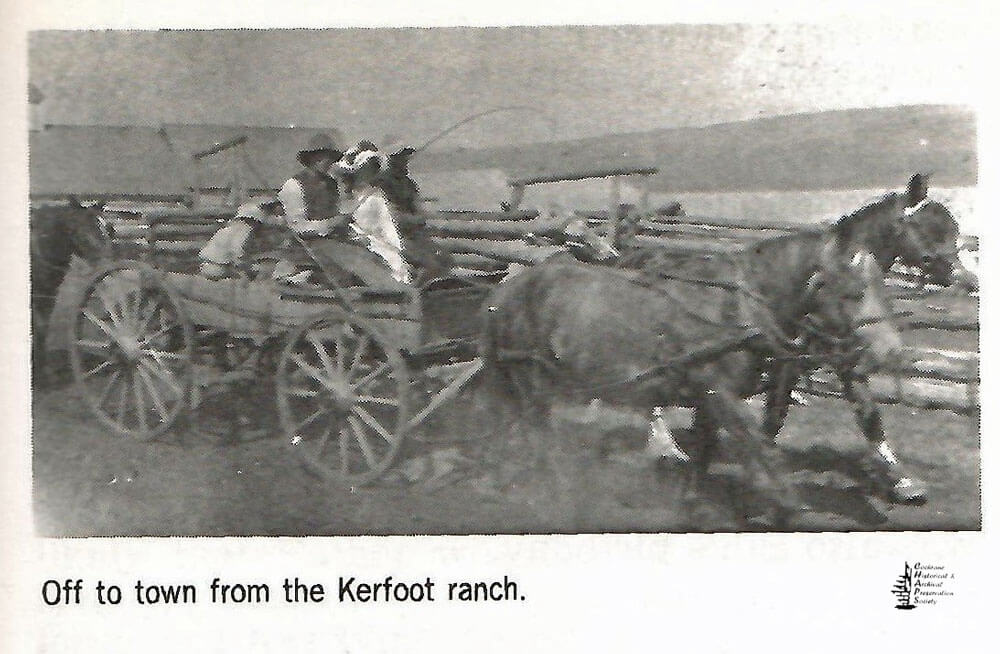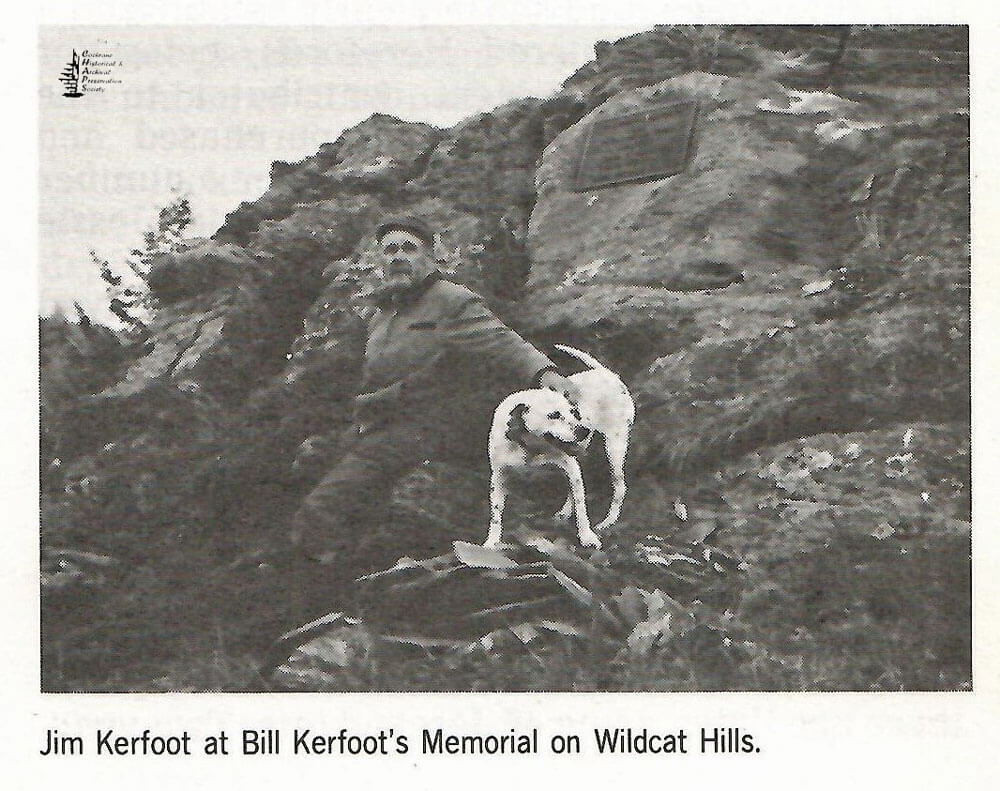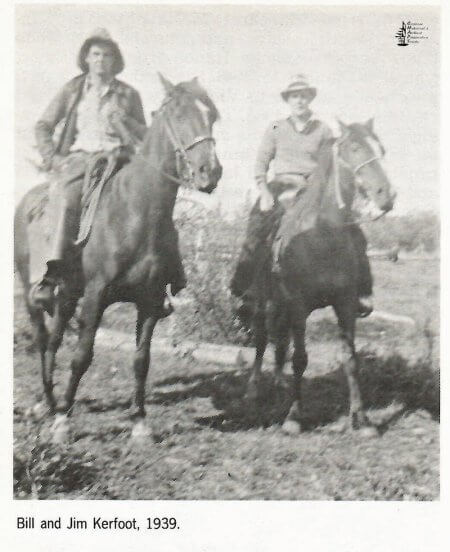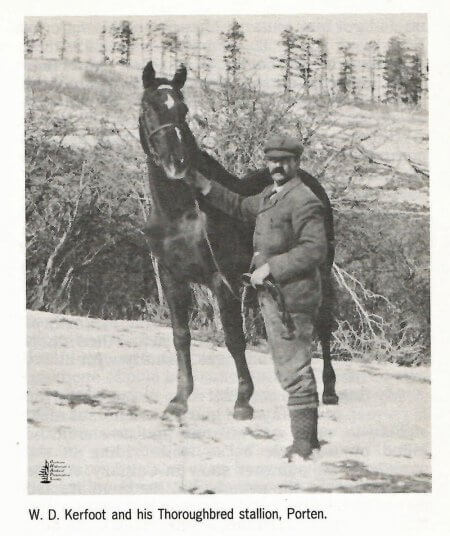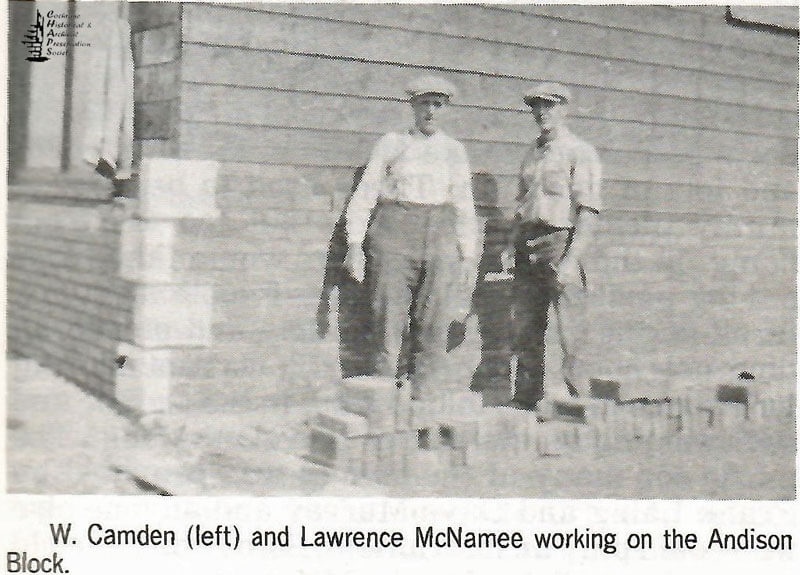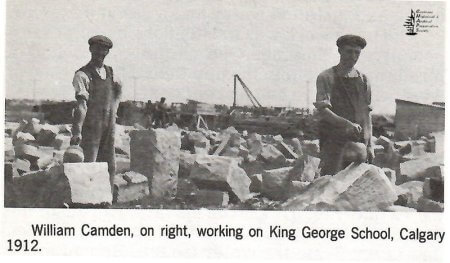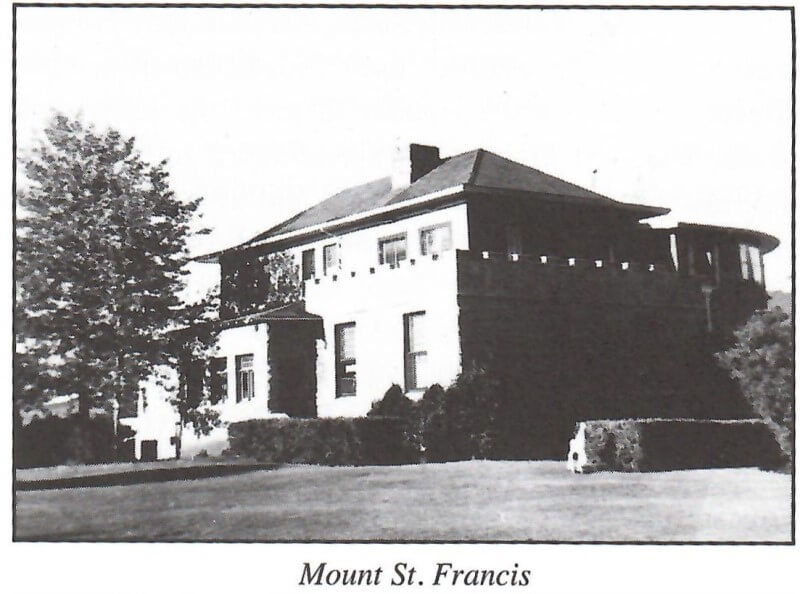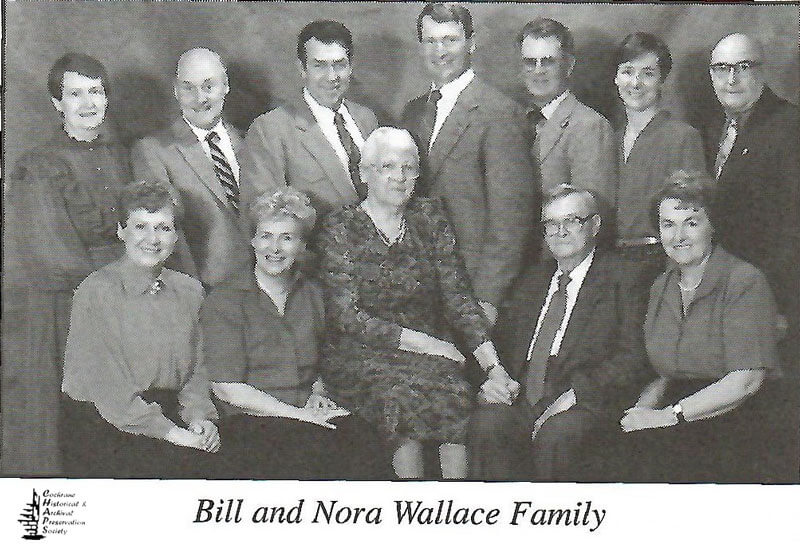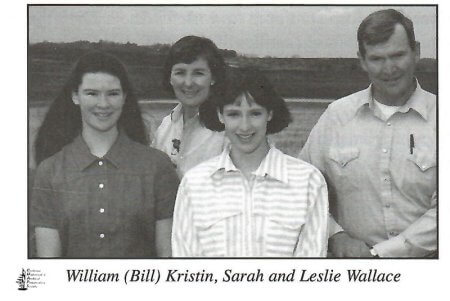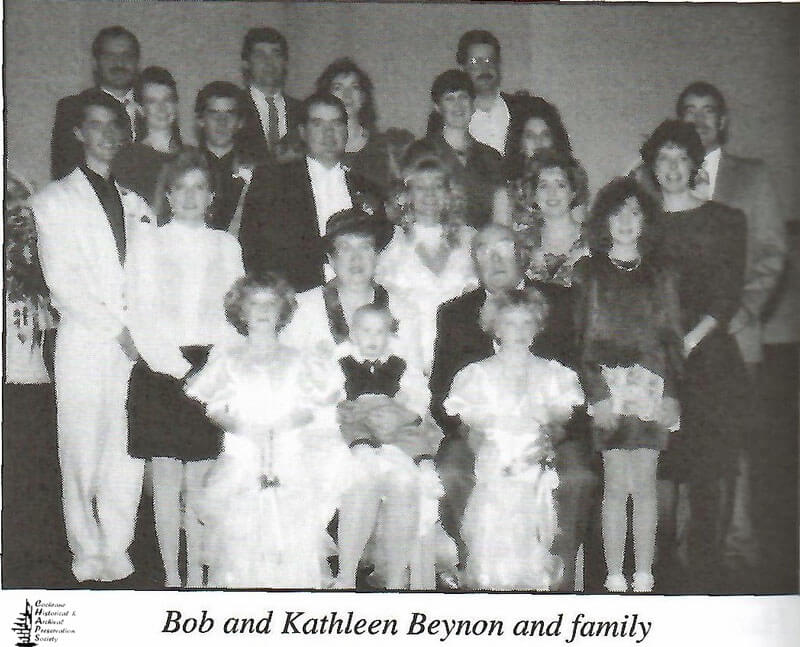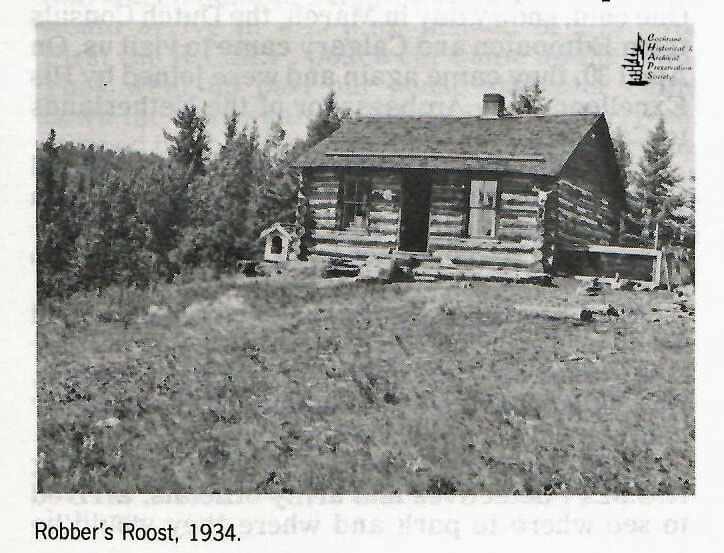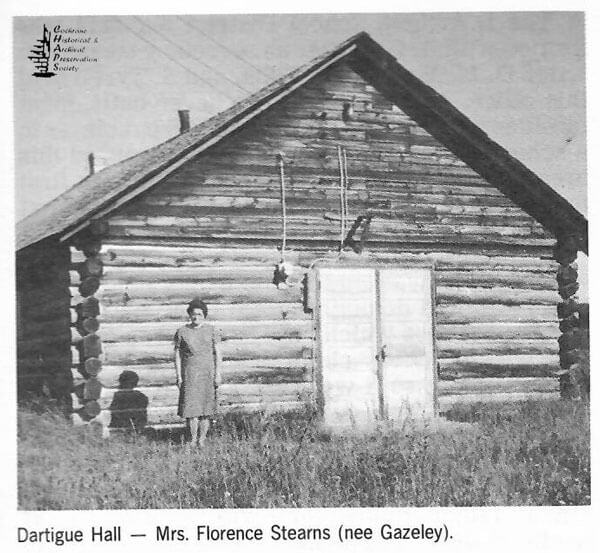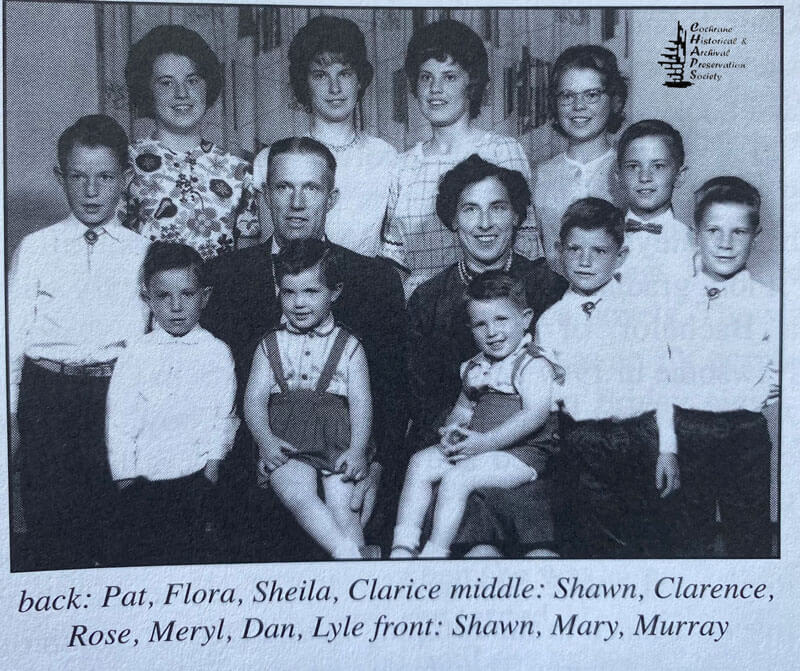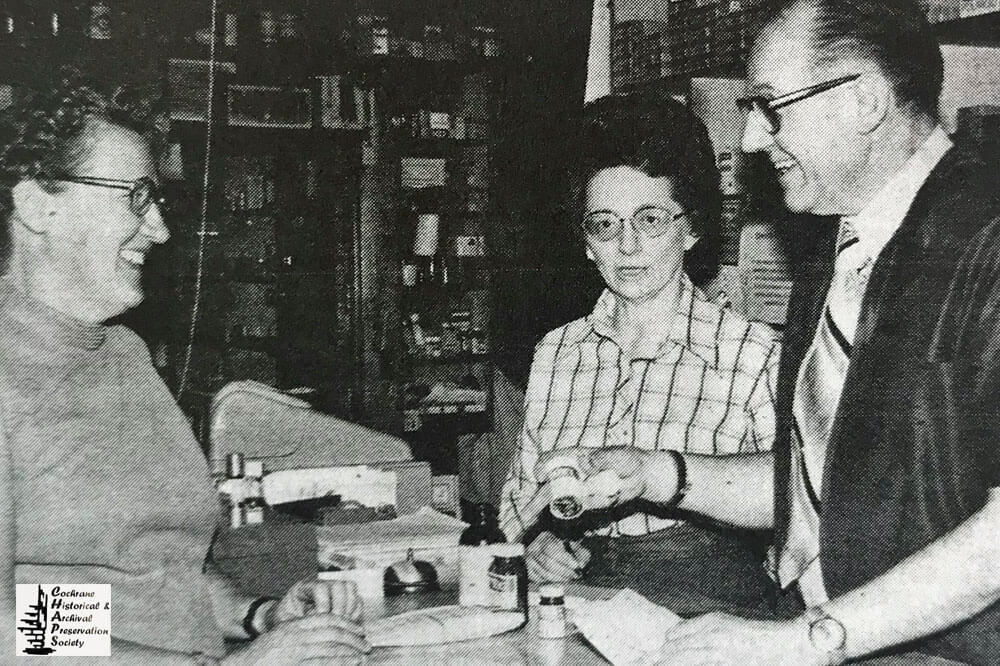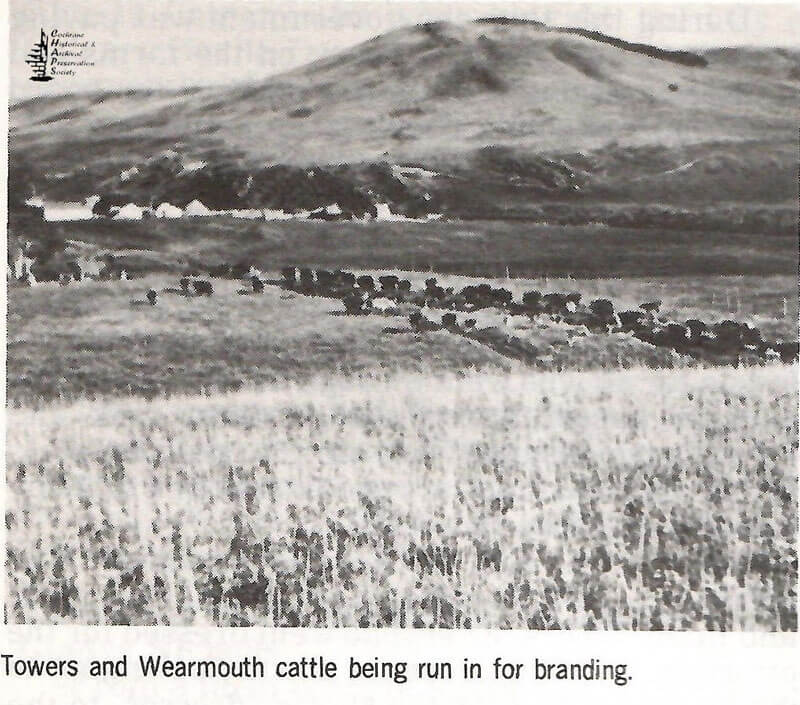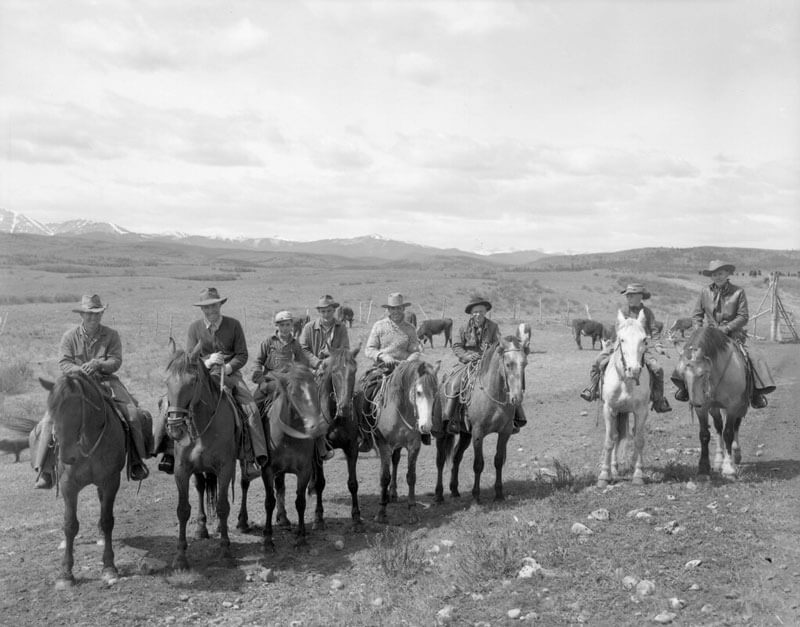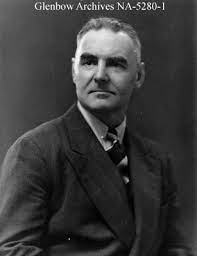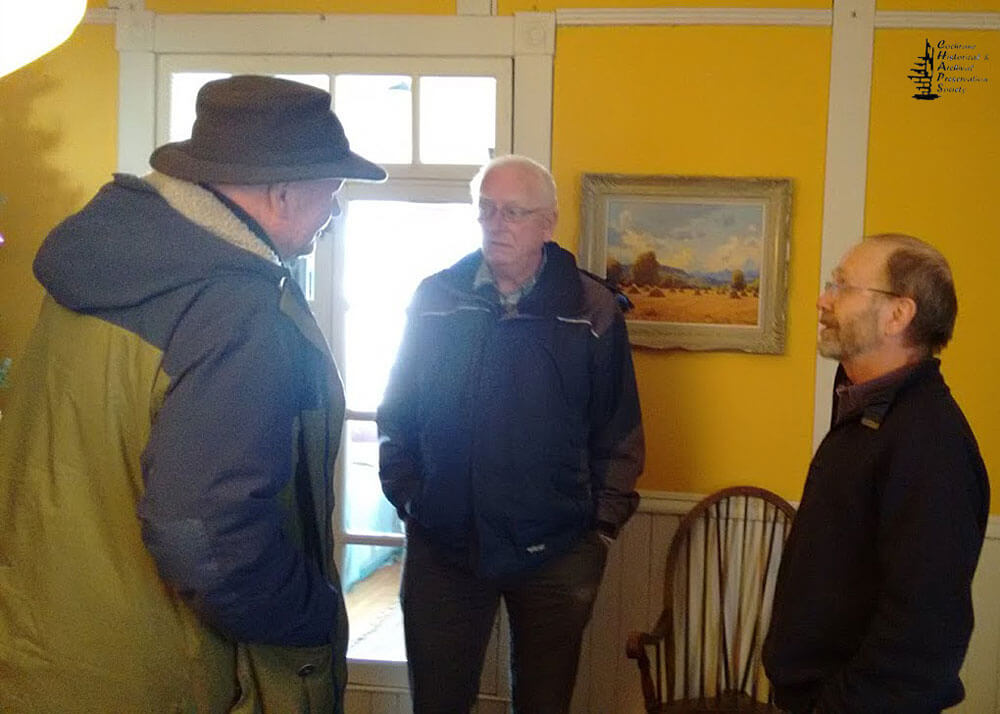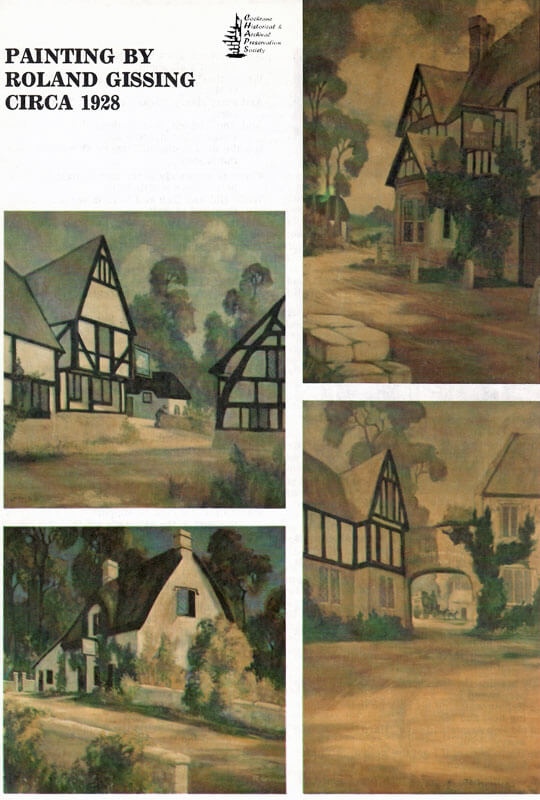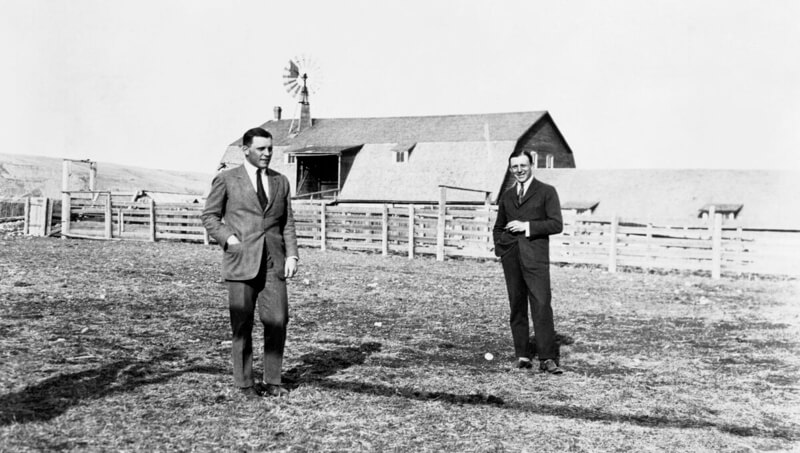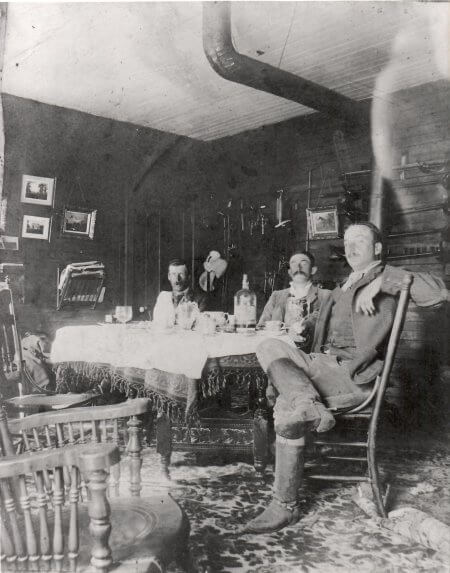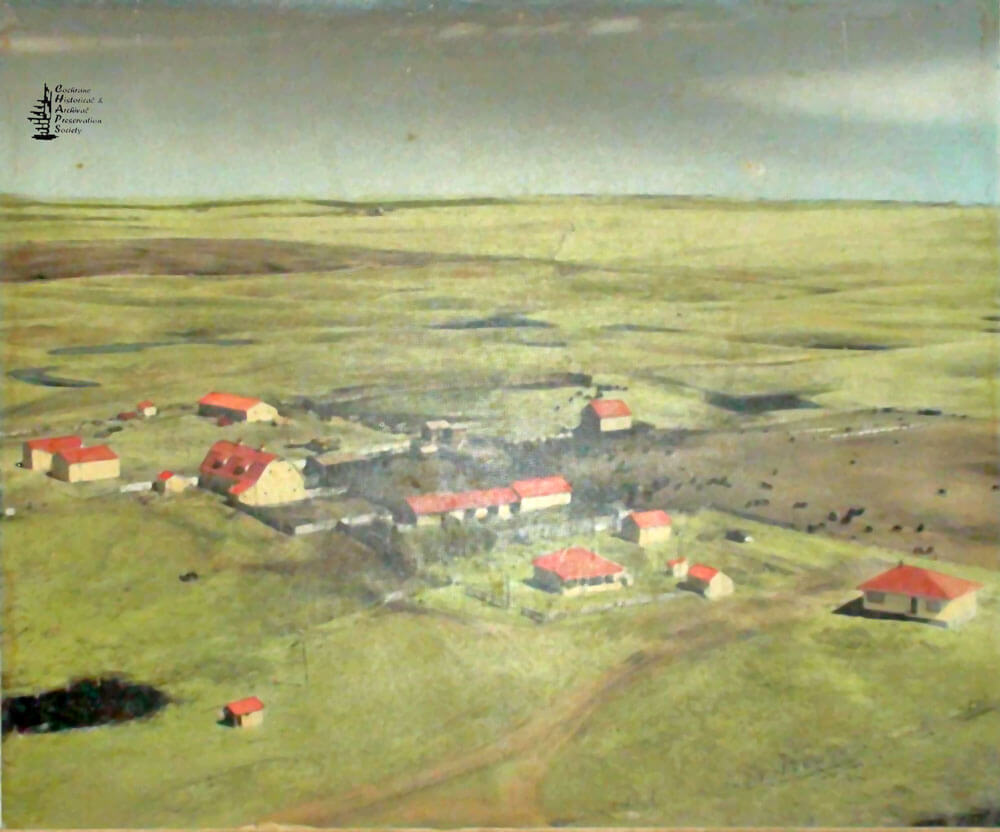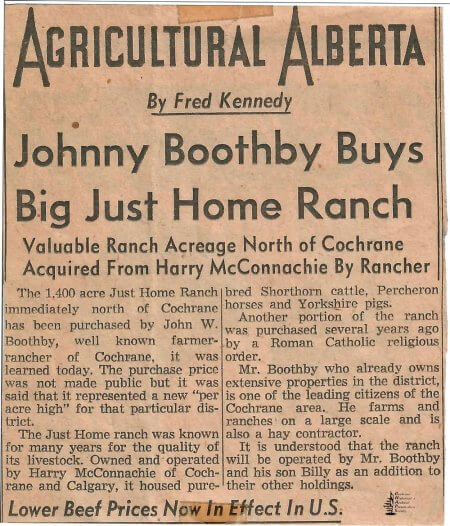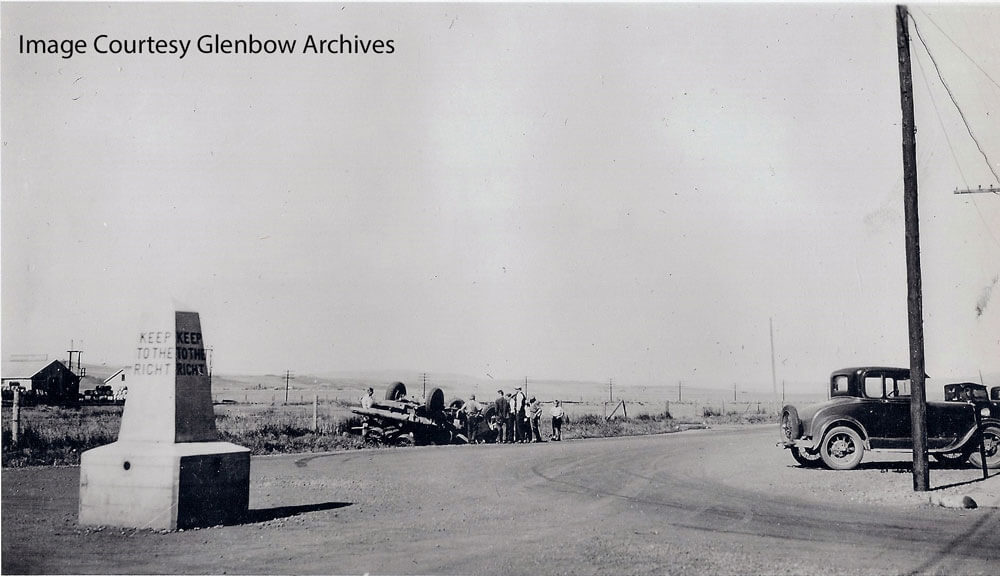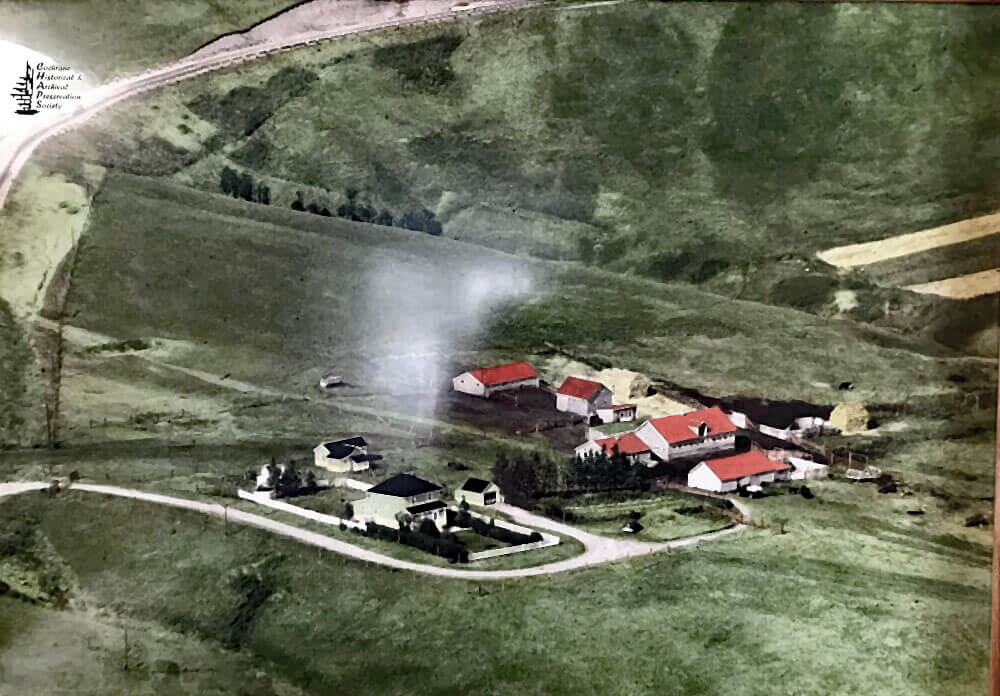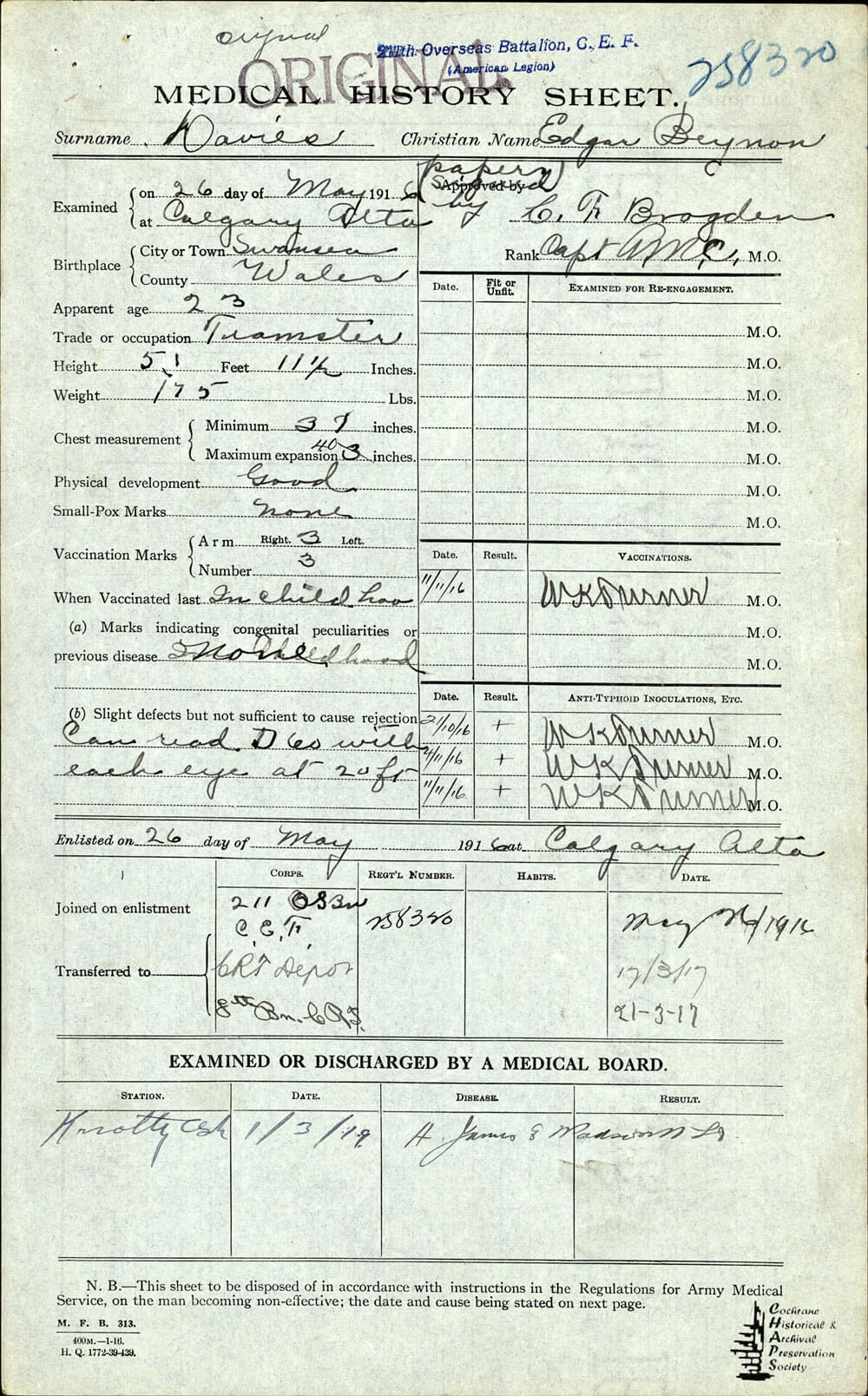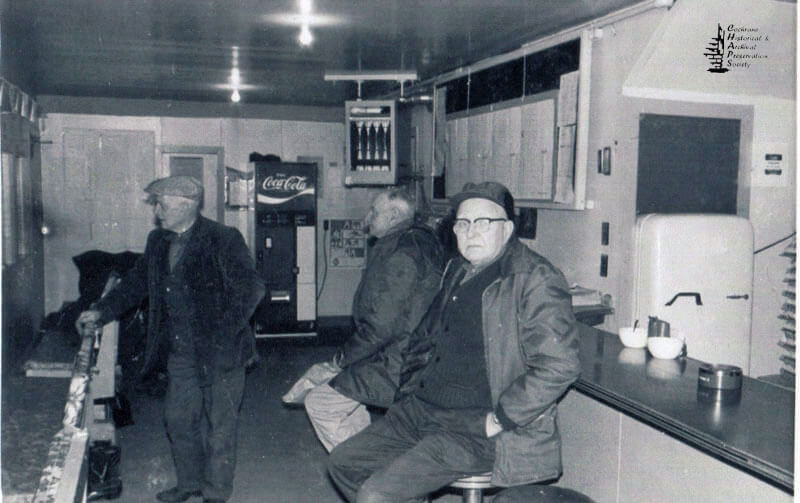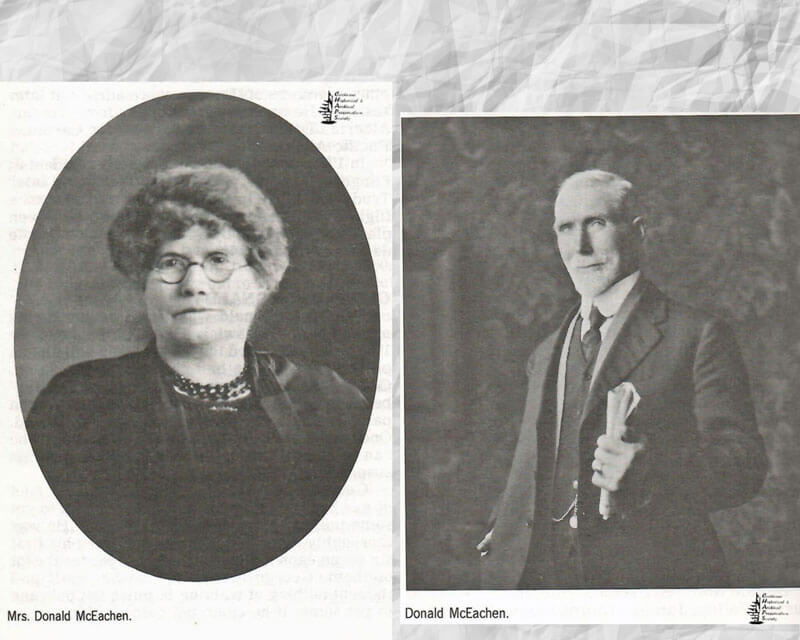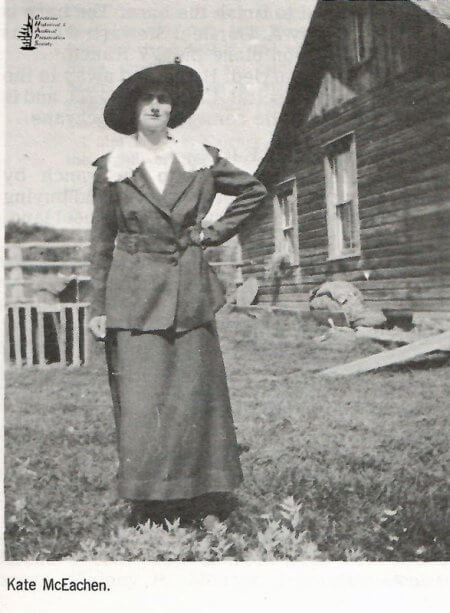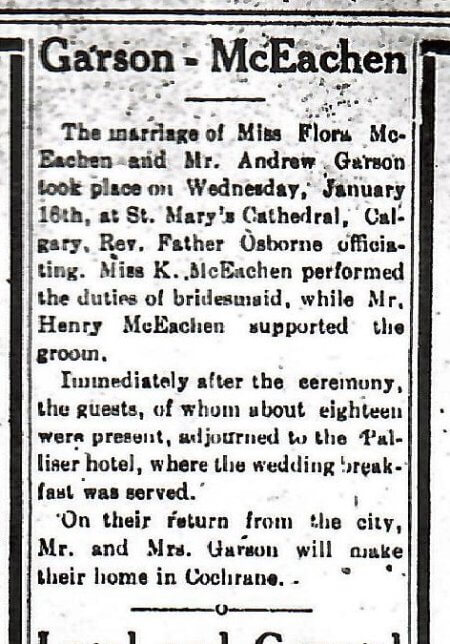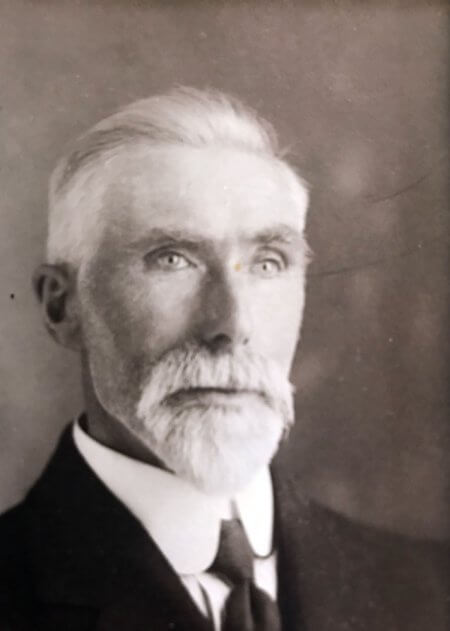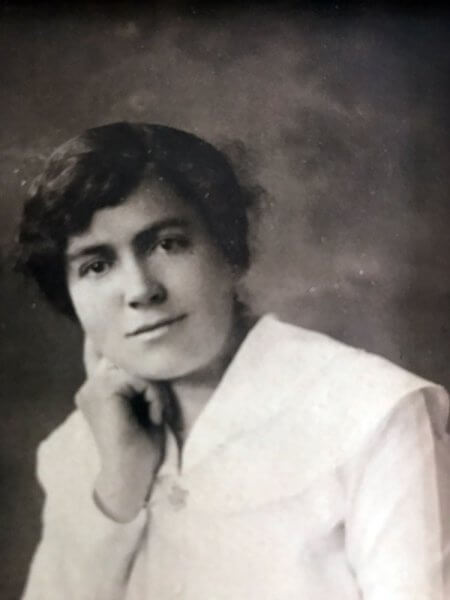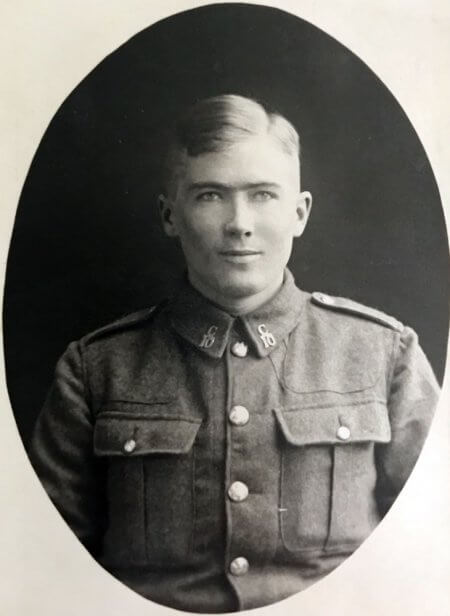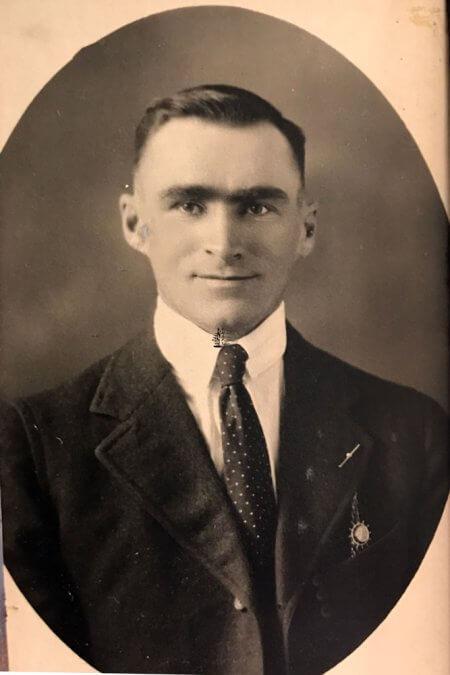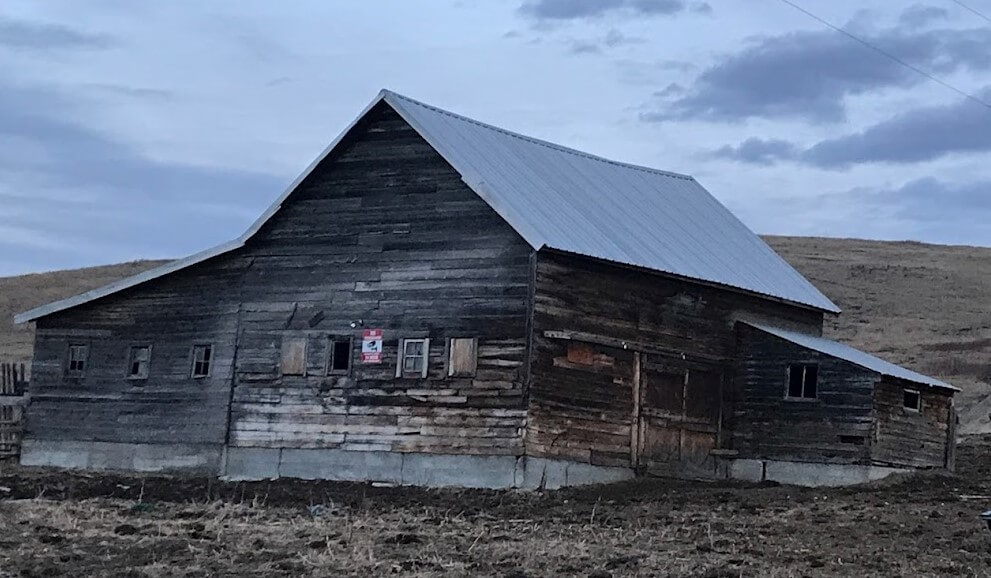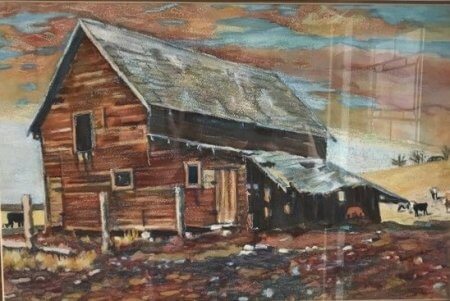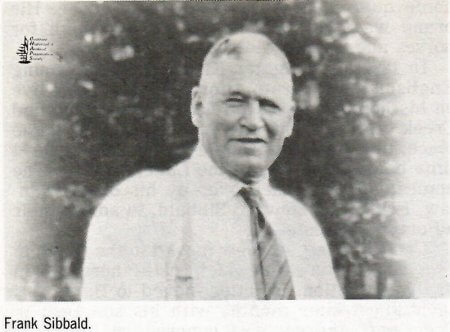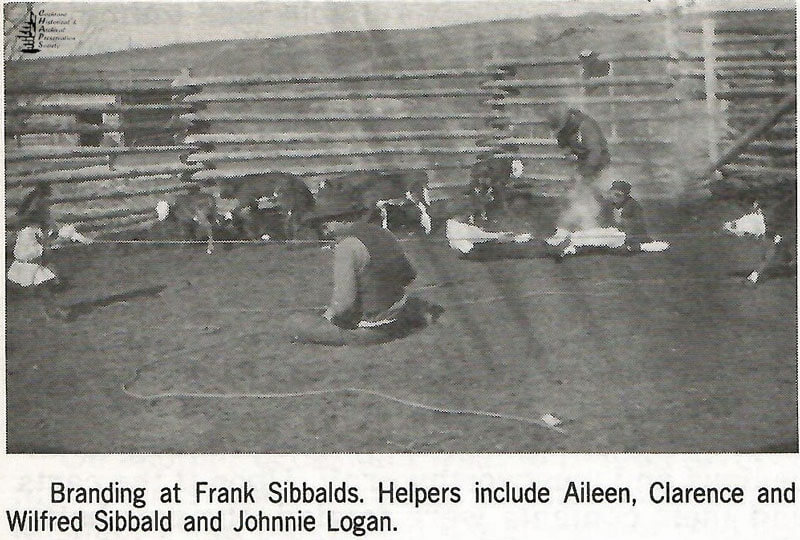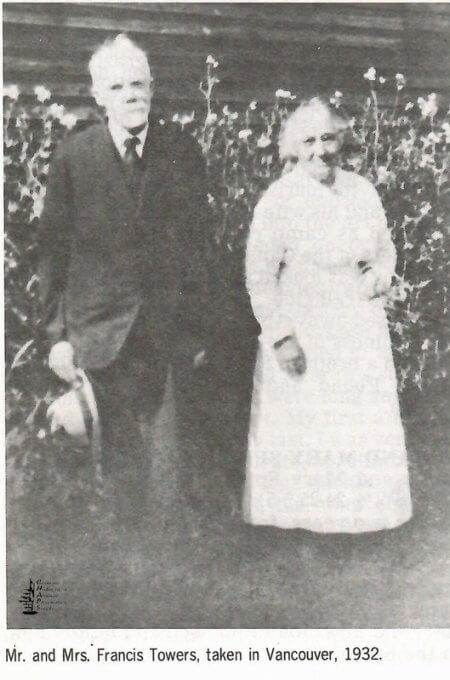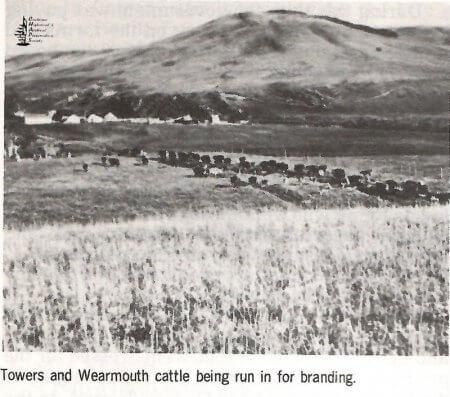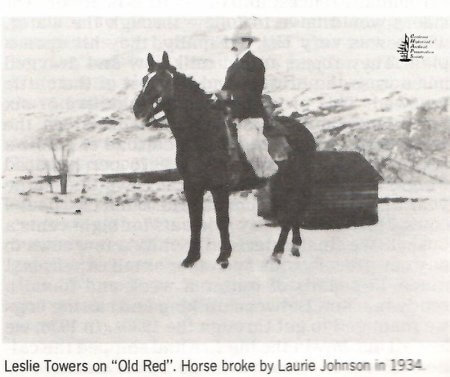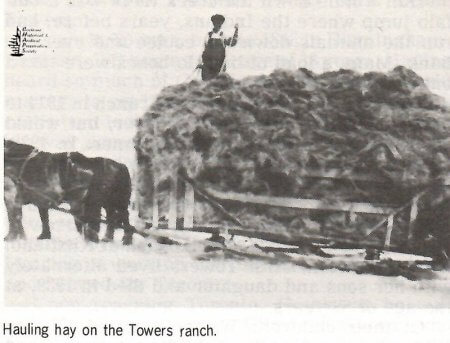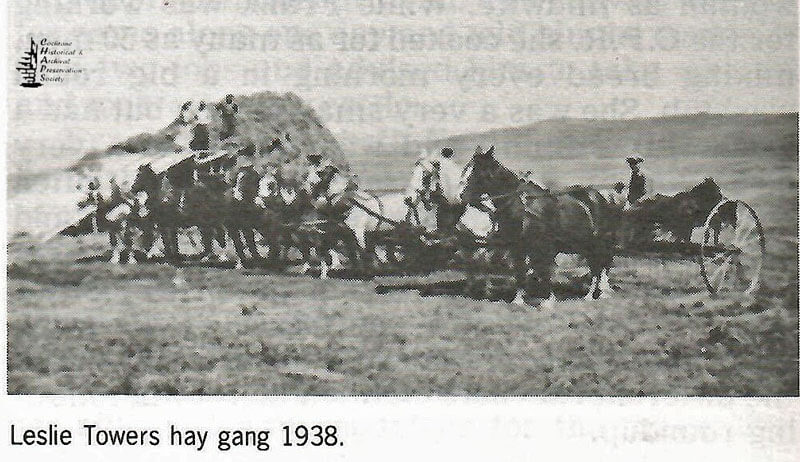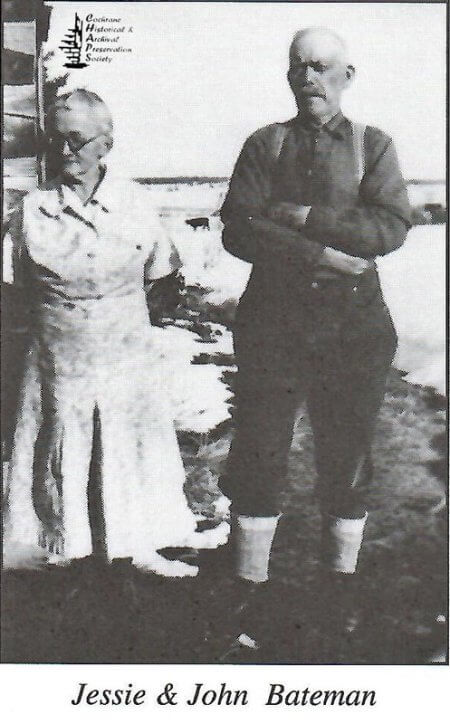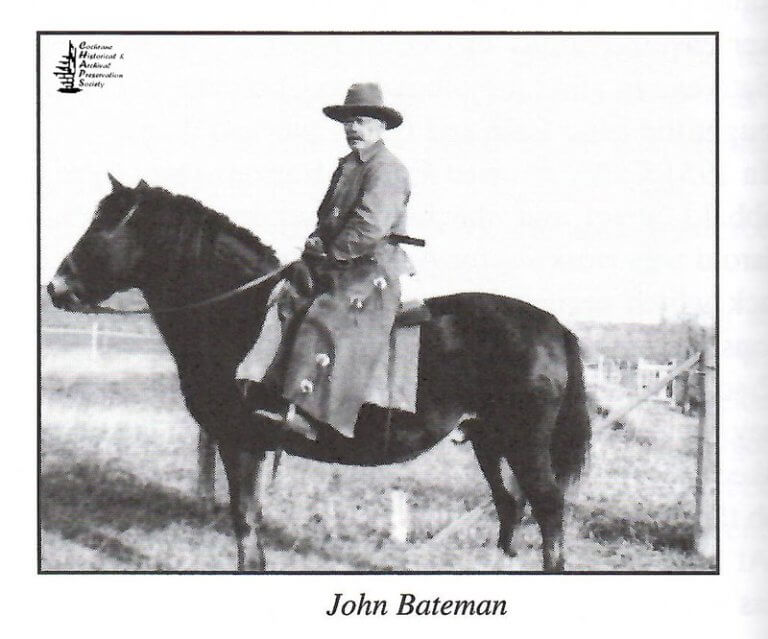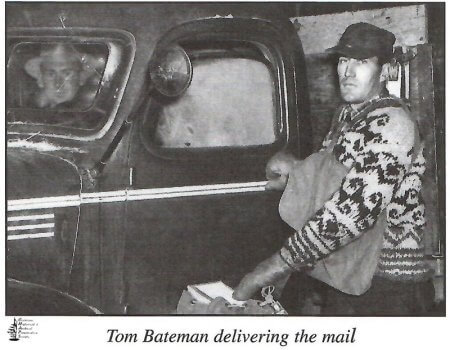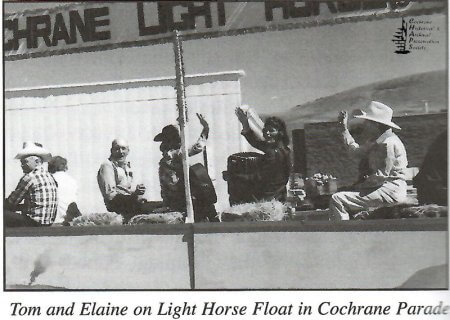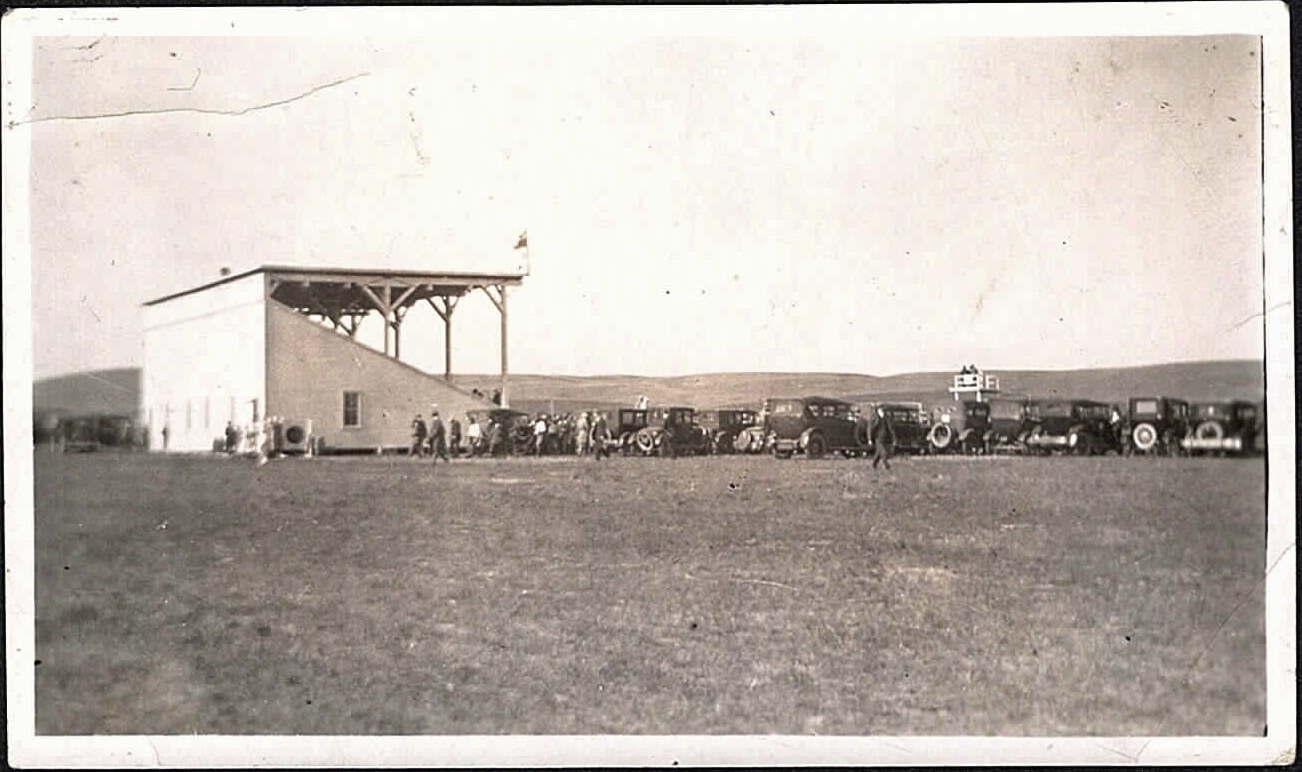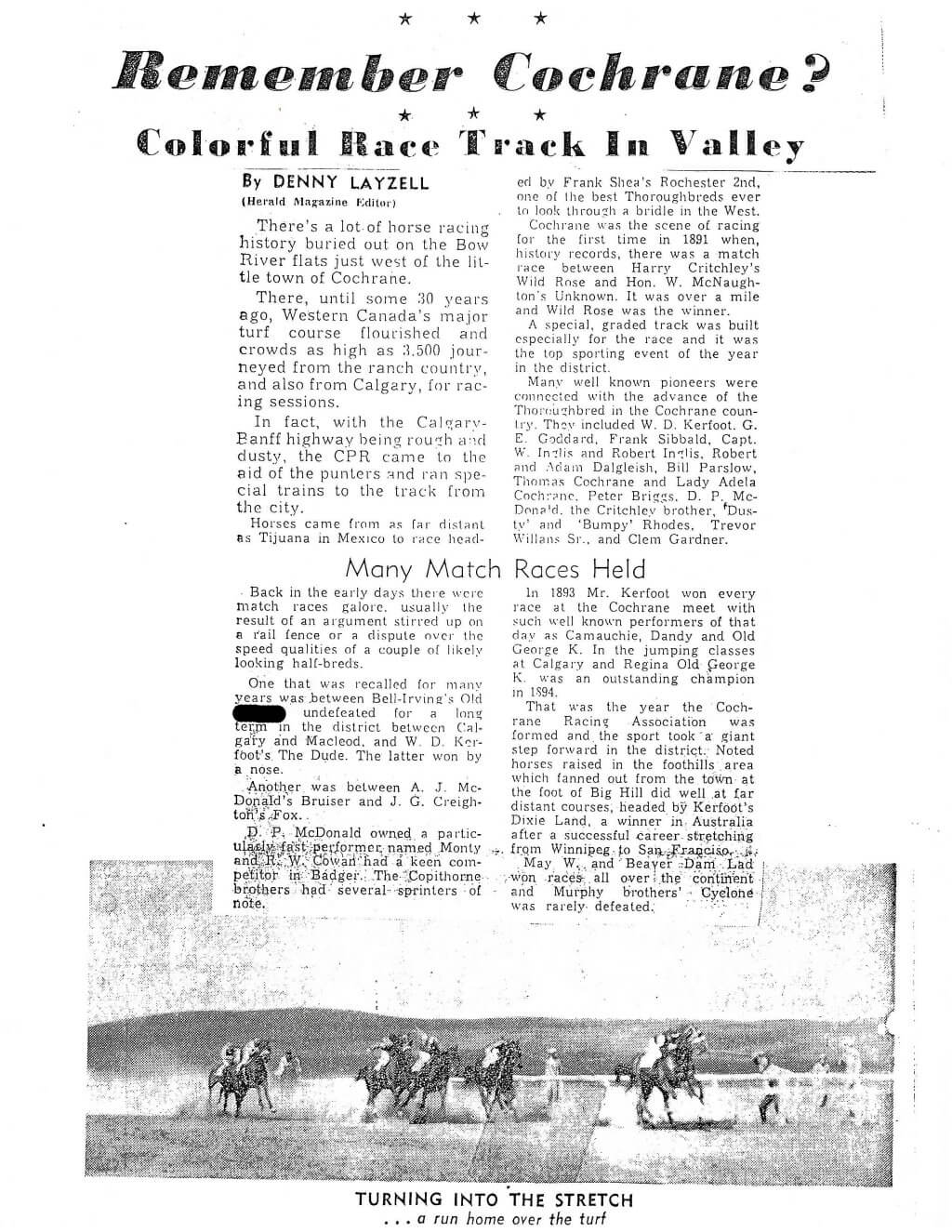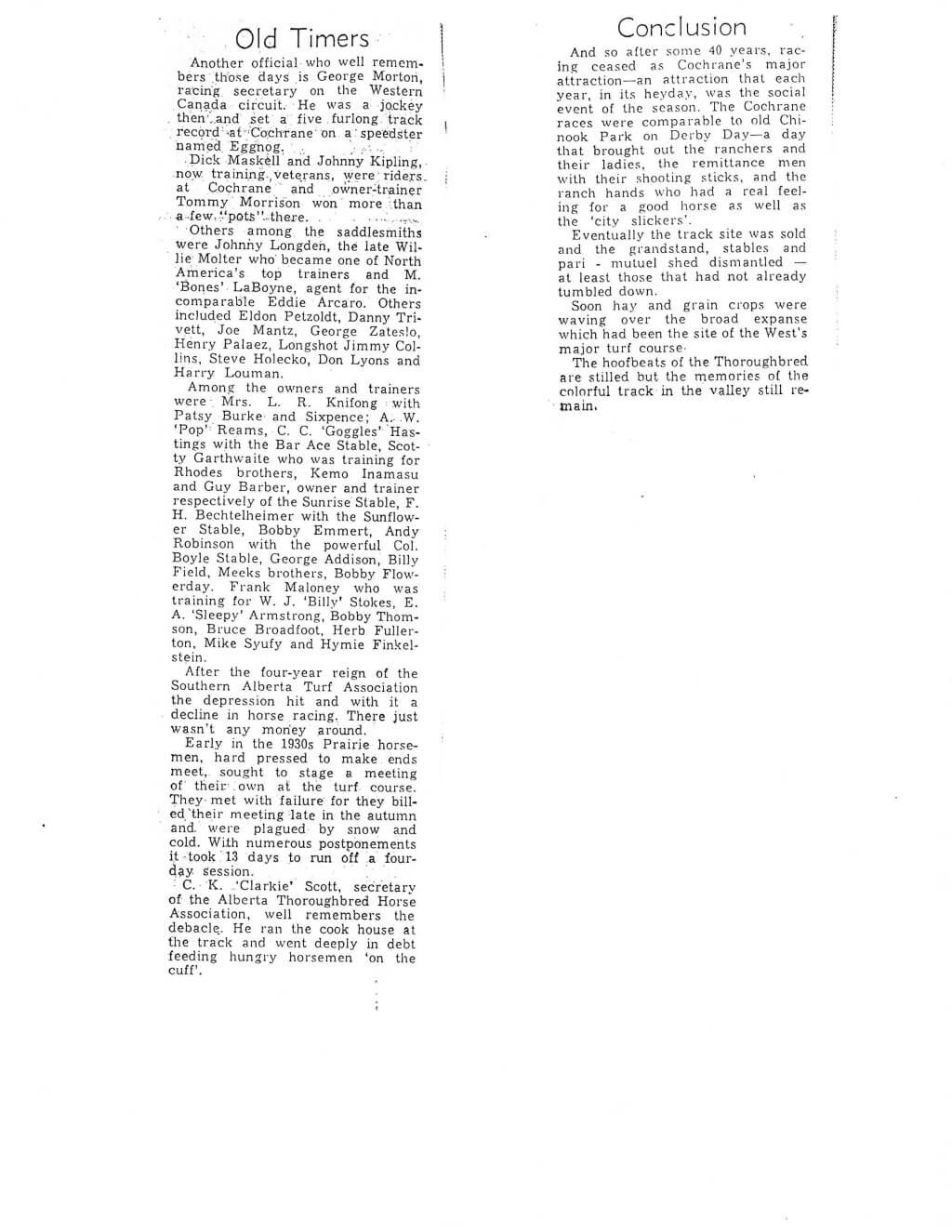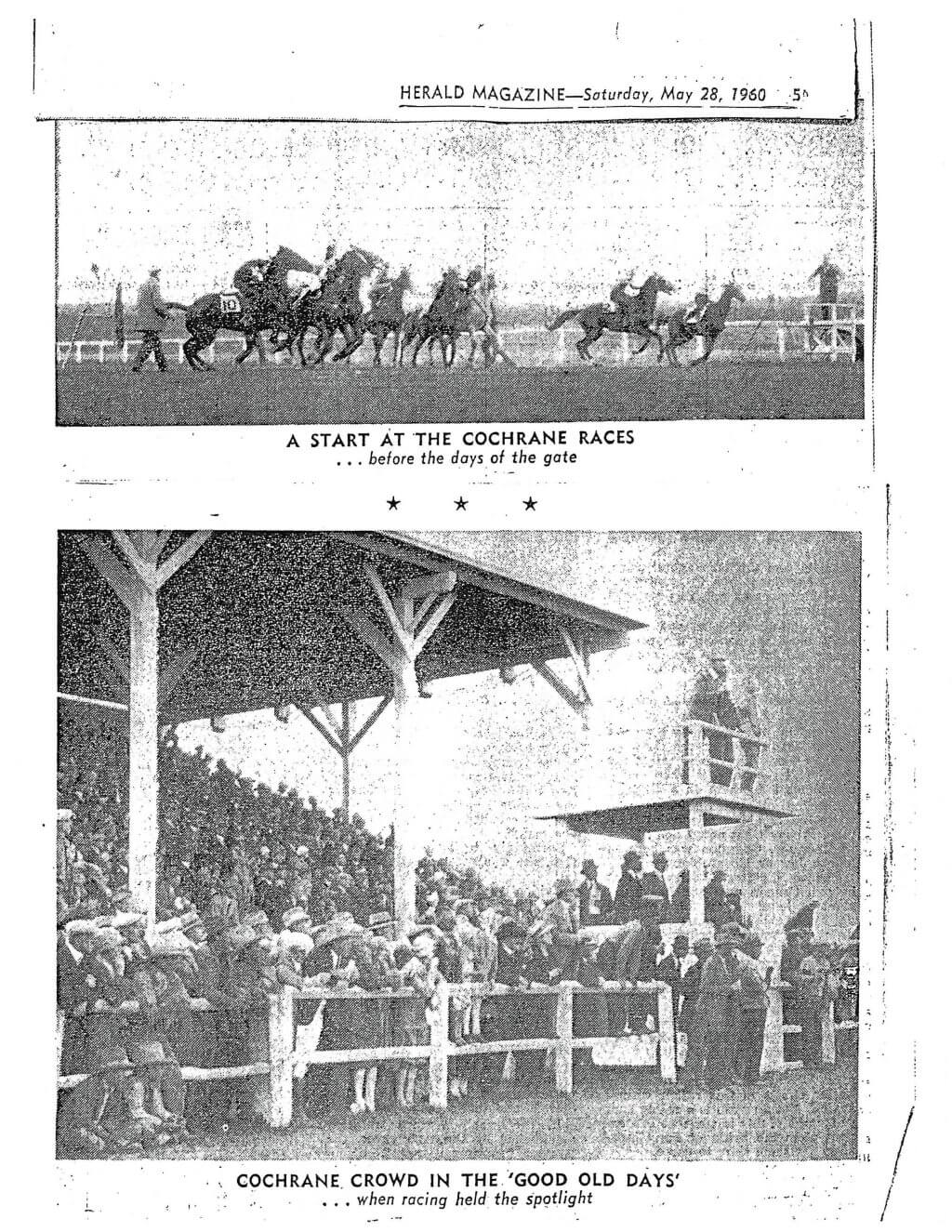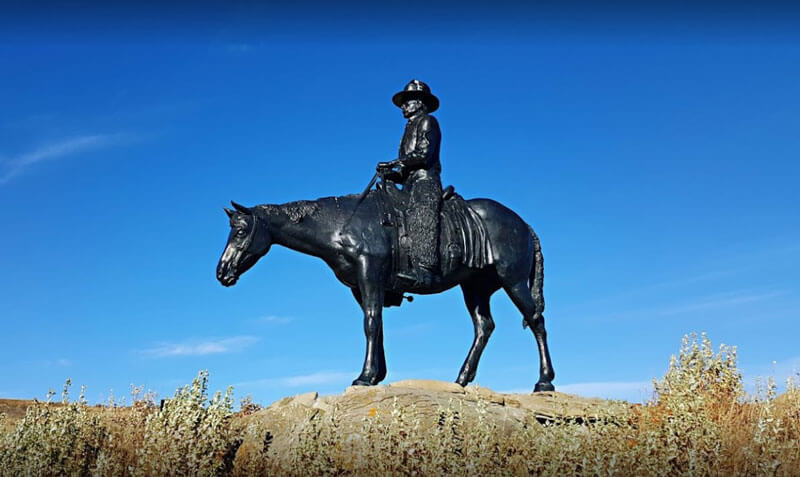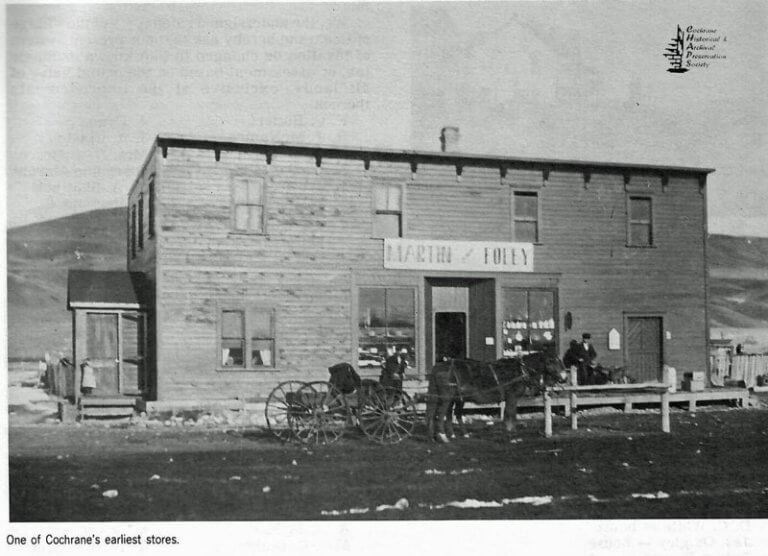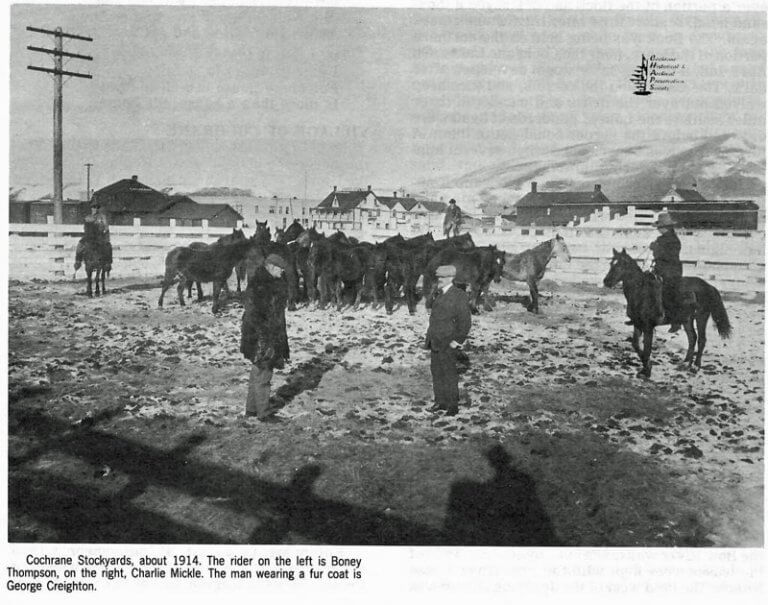by Mrs. Jack Poynter pg 307 Big Hill Country
For many years gymkhanas were held on what was known as the D. P. McDonald picnic grounds on the Mount Royal Ranch. When they were discontinued, Helen McDonald and Agness Hammond decided, in 1947, to form a pony club for contestants 18 years and under.
The first shows were held at Agness Hammond’s Ghost River Ranch (thus the name “The Ghost River Pony Club”). Agness received a cheque from Eric Harvie, a well-known Calgary oilman so that all entrants would receive a prize of some sort at the first show. For some years the prizes were donated by interested people.
Later the show was held on the Beaupre School grounds, now owned by the Beaupre Community Association. The show has been held there the third Sunday of August each year with the full co-operation of the weatherman to date.
Now, horse show and gymkhana events include all ages with some 26 English and Western classes.
Over the years many prominent judges have donated their services, judging classes with as high as fifty-four entries in one class.
Contestants pay only one entry fee for the horse, and one entry fee for the rider; this entitles them to take part in the day’s events and numerous classes.
By the late 1950s, the Club was in a financial position to purchase trophies as well as rosette ribbons for first, second, and third winners; ribbons for fourths, fifths, and sixths are given, depending upon the number of contestants in the class.
Over the years it has been considered one of the better shows in southern Alberta with as high as 124 horses being entered. Many entries are from contestants who travel the horse show and gymkhana circuits, making keen competition. Two former contestants who have represented Canada on the Olympic Equestrian Team are Barbara Kerr (neé Simpson) and Torchy Miller (nephew of Agness Hammond). Torchy received his first trophy here.
The Ghost River Pony Club has had many enthusiastic members and workers throughout the years; many have moved away, but return every year to visit and renew old friendships – some even have children and grandchildren competing.
In 1975 the Club had 24 members. This is a non-profit organization with hard-working dedicated members. For years, two generations of members were common; now there are two families represented by third-generation members.
by Dorothy Edge pg 167 More Big Hill Country
After the annual McDonald Picnic held on the Mount Royal Ranch in the Beaupre district ended in 1946, the late Agness Hammond, Ghost River Ranch, and late Helen McDonald, Mount Royal Ranch, neighbours, decided there really should be a local horse show and gymkhana in the area for children, so, in 1947, they set the wheels in motion and by August 29, 1948, the first show was held on the Ghost River Ranch, with lots of assistance from others. (See Page 307, Big Hill Country.)
The following details were taken from submissions sent to me for inclusion in GRPC’s scrapbook of memoirs.

A large crowd was in attendance and competition was keen at the horse show and gymkhana staged at Ghost River Sunday under ideal weather conditions. Many Calgary horse owners shipped their ponies to the ranch for the event and judge Miss Joan Arnold and Ian S. Brown of Calgary experienced a busy afternoon. Two spills were recorded during the afternoon, but the riders escaped with nothing worse than bruises and a shaking up. Ken Macmillan’s horse spilled in the stock horse event and Jaye Bowlen came a cropper in one of the jumping events. The youngest competitor at the show was Carolyn Kerfoot from the Grand Valley district, the winner in the lead line pony class. A number of useful prizes and trophies were awarded to the winning contestants as follows:
winner in the lead line pony class. A number of useful prizes and trophies were awarded to the winning contestants as follows:
Best pony ridden by a boy or girl, 10 years and under
- Ken Macmillan
- Dorothy Bryant
- Morna Riley
- Mary Whittaker
Best pony ridden by boy or girl, 10 years to 16
- Anita Eyma
- Edith Edge
- Frank Edge
- Mary Saucier
Best riding horse, ridden by boy or girl 16 years to 20
- Donna Johnson
- Kaye Bowlen
- Edith Edge
- Peggy Johnson.
Best maiden pony or horse, open to first and second prize winners of first three classes
- Ken Macmillan
- Anita Eyma
- Dorothy Bryant.
Best boy or girl rider, 10 years and under, open to those who have never won a first or second at any recognized show
- Johnny Poynter
- Bill Ullery
- Mary Whitaker
- Dorothy Bryant
Best boy or girl rider, 11 to 16,same stipulations
- Frank Edge
- Anita Eyma
- Mary Saucier
- Jay Eyma.
Best boy or girl rider 16 years and under, open to all
- Sheila Robertson
- Peggy Johnson;
- Marilyn Macmillan
- Dolores Bowlen.
Open to horse or pony ridden by rider any age open to all horses on grounds
- Anne Marshall on Dynamite
- Peggy Jean Robertson on Beauty
- Donna Johnson on Claudia
- Jaye Bowlen on Peggy.
Stock Horse Class ridden by boy or girl 14 years of age or under
- Peggy Jean Robertson
- Jay Eyma
- Jaye Bowlen
- Anita Eyma.
Stock Horse Class ridden by boy or girl 15 to 20
- Stewart Robertson
- Peggy Johnson
- Joy Gainor
- Donna Johnson.
Jumping open to all boys or girls 14 years and under
- Jay Eyma
- Peggy Jean Robertson
- Jay Eyma
- Frank Edge.
Novice Jumping 15 to 20 years
- and 2. Leon Delbeke
- Stewart Robertson
- Peggy Johnson.
Bareback Jumping open to boys or girls, any age
- Peggy Jean Robertson
- Leon Delbeke
- Joy Gainor
- Leon Delbeke.
Open Jumping – open to all
- Eddie Bowlen on Peggy
- Joy Gainor on Allah
- Jay Eyma on June
- Jay Eyma on Kitty.
Lead Line Class boys or girls six years of age and under
- Carolyn Kerfoot
- Mary Copithorne
- Luke Lindoe
- Bryan Coleman.
Horse Judging Contest boys and girls 14 years of age and under
Anita Eyma.
Horse Judging Contest boys or girls 15 to 20
Joy Gainor.
Gymkhana Events By Anita Eyma Kessler, 1998.
Leading Race boys and girls 12 years of age and under
- Jay Eyma
- Anita Eyma
- Ken Macmillan
- Johnny Poynter.
Musical Chairs boys and girls 14 years of age and under
- Peggy Jean Robertson
- Edward Jull
- Sheila Robertson
- Anita Eyma.
Musical Chairs boys and girls 15 to 20
- Stewart Robertson
- Dolores Bowlen
- Neil Harvie
- Edith Edge.
Walk, Trot, and Run Race boys and girls 13 to 20
- Joy Gainor
- Donna Johnson
- Norman Edge
- Douglas Johnson.
Potato Race boys and girls 14 years and under
- Peggy Jean Robertson
- Anita Eyma
- Cliff Butler
- Johnny Poynter.
Potato Race open to boys and girls 15 years and over
- Larry Way
- Donna Johnson
- Neil Harvie
- Bob Orr.
Bending Race boys and girls 15 years and over
- Don Edge
- Larry Way
- Neil Harvie.
Guy Gibson’s Challenge Trophy bareback relay race, boys and girls 12 to 16 years
- Jay Eyma
- Bob Orr
- Peggy Johnson
- Peggy Jean Robertson
Indian Riding Class
- Johnny Lefthand
- Sykes Powerface
- Ross Smalleyes
- David Bearspaw
- Alfred Labelle.
The Ghost River pony show was not only a learning experience but was also one of the few social opportunities available fifty years ago. For many of us in the surrounding valleys, the only two social events were the Ghost River Horse Show and the Morley Stampede. Dog Pound was for the adventurous among us. If the weather was rainy, we held our breath approaching the difficult spots in the poor roads. A spring running across the wagon trail near Grandma Ford’s in Jackass Canyon could be our undoing. If the old car slid down the incline, we were done and had missed out on seeing people and having fun. We needed Dave Bryant and his machinery then, but that came much later, with resultant good roads.
Getting to Beaupre Creek School in the summer was enjoyable. It was only a four-mile ride on horseback. Riding there during the winter of the school term, together with some years with as few as eight students and a very young or a very old teacher, was not always as pleasant. Thank goodness for the coal and wood stove.
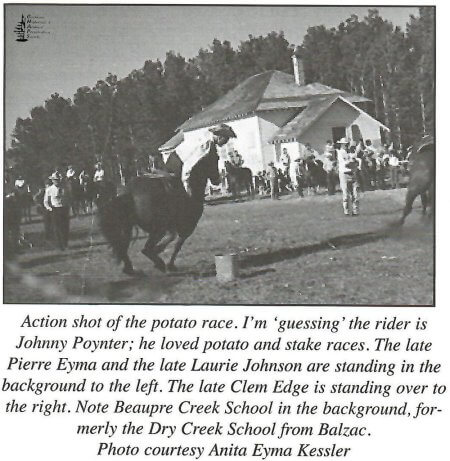
In the beginning, clothing to show was just whatever we had. Often, western boots went into English saddle stirrups. Ill-fitting jeans and a shirt made up the rest of the ensemble for growing competitors. Horses and tack were very important, however, parents did their best to provide a fine animal and serviceable saddle, both of which were used all year round to work the ranch.
My brother, Jay, could get the most out of a jumper. Even our “kid’s pony,” Tiny, would cheerfully clear hurdles for him. Donna (Johnson) Butters described Tiny as a “good honest mare.” The greatest satisfaction for me came from winning the horse-judging contest at the first gymkhana, being I was too timid to attempt riding over jumps.
Pierre, my father, took his responsibilities as an officer of the Pony Club very seriously. His capabilities and conscientiousness were a wonderful and lasting example to his children and perhaps even to others. He would have been so pleased that the organization and all the good it stood for survived for fifty years and will not be forgotten by those who participated. There could be no finer legacy than the spirit of the Ghost River Pony Club.”
The Ghost River Pony Club’s 50th Anniversary and final show were held at the Beaupre community grounds on August 16, 1998, in memory of Agness Hammond and Helen McDonald. Announcer Maureen Wills conveyed accolades in their memory. And she remembered Vivienne Ullery, who contested in her last show here at age 80. Two senior members in attendance, Marie Eyma and Jim Kerfoot, were recognized for their outstanding contributions over the years. A special tribute was extended to Tilda Millar (Agness Hammond’s sister, and Torchy Millar’s mother) for donating funds to ensure trophies and ribbons were extra special for the final show, and to Griffin Valley Ranch for donating the Lead Line Class trophies. She then called on President Don Edge, who presented Chris Montague from the Cochrane Lions with a plaque thanking them for handling the concession booth for ‘umpteen years.
Show organizers were President Donald Edge, Past President Linda Beddoes, Vice-President John Poynter, Secretary-treasurer Dorothy Edge, Publicity Kathy Wills and fellow directors Ann Hindes, Suzy Poynter, Cindy Renwick, Bob and Mary-Jane Pogue, Grant McNabb. Pat and Val Scholefield, Maureen Wills, Erik Burners, and Hamish Kerfoot. Our judges were Bud Wyatt, Western, and John Simpson, English. The later grew up competing in this show and were pleased to help and shared their memories with everyone. In appreciation, the two judges and each director received a bronze belt buckle made by the late Mac MacKenzie that incorporated Cathy Wills’ insignia of the lovely gold commemorative 50th Anniversary pin she designed as a souvenir for all the patrons.
Everybody loved the GRPC horse show and gymkhana and a large crowd attended the 50th show. Sixty-eight contestants entered. Donna (Johnson) Butters was a keen competitor in 1948 and in 1998. Several four generations of family members competed at this show over the years.
Ghost River Pony Club
Results of 50th Anniversary and Final Show August 16, 1998.
Halter Class – Foal
- Kathy Fenton
- Laura Hughes.
Halter Class – Yearling
- Gloria Cross
- Holly White
- Laura Hughes
- Kathy Fenton
- Duncan Kerfoot.
Halter Class – Two-year-old
- Kathy Fenton.
Halter Class – Mares, three years old and over 14 hands and over
- Mary Pearson
- Laura Hughes
- Wayne Jubb
- Patsy Parker
- Catherine Stewart
- Clem Kirk.
Halter Class – Geldings, three years old and over, 14 hands and over
- Heather Craig
- Twylla Bruhn
- Janice Hepburn
- Duncan Kerfoot
- Robin Willet
- Marri Keith.
Halter Class – Mares and Geldings, three years and over, 14 hands and over
- Brenna Managhan
- Curtis Kronlund
- Liam Kronlund
- Jordon Tresidder
- Ian Stewart.
English Equitation – 17 years and over (horse not to count)
- Rosemarie Jubb
- Donna Butters
- Patsy Parker
- Heather Craig
- Leslie Anderson
- Janice Hepburn
Western Equitation – 9 to 12 years (horse not to count)
- Kayla Welsh
- Courtney Arneson
- Justine Simpson
- J. D. Watt
- Danielle Kilbourn
- Tyler Fyten
Western Equitation – 13 to 16 years (horse not to count)
- Alison Barr
- Claire Arneson
- Kim Groves.
Western Equitation – 8 years and under (horse not to count)
- Carlee Edge
- Susan Griffin
- Austin Fyten
- Tereasa Keith
- Montana Renwick
- Amber Lynn Beeby
English Equitation – 9 to 12 years (horse not to count)
- Catherine Stewart
- Jessica Kronlund
- Curtis Knonlund
- Brenna Monaghan
- Danielle Kilbourn.
Western Equitation – 17 years and over (horse not to count)
- Rosemarie Jubb
- Holly White
- Leslie Anderson
- Anita Panjwani
- Ron Hanson
- Sonja Hustad
English Equitation – 8 years and under, (horse not to count)
- Elizabeth Stewart
- Liam Kronlund
- Ian Stewart.
Western Equitation – 13 to 16 years (horse not to count)
- Megan Wiltshire
- Colby Simpson
- Sarah Willet
- Marri Keith
Lead Line Class
Carlee Edge, Okie Iredale, Caitlin Fyten, Sam Edge, Skylar Iredale, Carlee Poynter, Jordon Jubb, Emily Adlington, Amber Lorenz, Colby Stonham, Braden Poynter. They all won prizes.
Junior English Pleasure – 16 years and under
- Alison Barr
- Curtis Knonlund
- Claire Arneson
- Catherine Stewart
- Kim Groves
- Jessica Knonlund
Senior Western Pleasure – 17 years and over
- Holly White
- Rosemarie Jubb
- Janice Hepburn
- Leslie Anderson
- Twylla Bruhn
- Anita Panjwani
Pony Class – 14 years and under (12.2 hands and under)
- Liam Knonlund
- Brenna Monaghan
- Susan Griffin
- Jordon Tresidder
Senior English Pleasure – 17 years and over
- Donna Butters
- Mary Hilderbrandt
Junior Western Pleasure – 16 years and under
- Courtney Arneson
- Kayla Welsh
- Justine Simpson
- Colby Simpson
- Sarah Willet
- Megan Wiltshire
Sack Race – 5 years and under
- Susan Griffin
- Carlee Edge
- Sam Edge
- Colby Stonham
- Emily Adlington
- Okie Iredale
Sack Race – 6 to 8 years
- Samantha Watt
- Ian Stewart
- Teresa Keith
- Montana Renwick
- Jordon Tresidder
- Liam Knonlund
Junior Jumping – 10 years and under
- Curtis Knonlund
- Elizabeth Stewart
- Liam Knonlund
- Brenna Managhan.
Intermediate Jumping – 11 to 14 years inclusive
- Catherine Stewart
- Jessica Knonlund
- Claire Arneson.
Senior Jumping – 15 years and over
- Alyssa Butters
- Jessica Knonlund
- Alison Barr.
Junior Pole Bending Race-10 years and under
- Riley Jones
- Elizabeth Stewart
- Samantha Watt
- Susan Griffin
Intermediate Pole Bending Race 11 to 14 years inclusive:
- Courtney Arneson
- Colby Simpson.
Senior Pole Bending Race – 15 years and over
- Stephanie McKinnon
- Ron Hanson
- Twylla Bruhn.
Junior Potato Race – 10 years and under
- Riley Jones
- Carolyn Kolb
- Samantha Watt
- Susan Griffin
Intermediate Potato Race 11 to 14 years, inclusive
- Colby Simpson
- Danielle Kilbourn
- Pat Griffin
- Claire Arneson
Senior Potato Race – 15 years and over
- Ron Hanson
- Ken Iredale
- Corrine Coverdale
- Laura Hughes.
Junior Musical Tires – 11 to 14 years, inclusive
- Mary Keith
- Catherine Stewart
- J.D. Watt
- Colby Simpson
- Meaghan Groves
- Claire Arneson.
Senior musical Tires – 15 years and over
- Megan Wiltshire
- Ron Hanson
- Brandy Wiltshire
- Kathy Fenton
- Joe Simpson
- Terry Edge
Junior Stake Race – 11 to 14 years, inclusive
- Colby Simpson
- Claire Arneson
- J. D. Watt
- Courtney Arneson.
Intermediate Stake Race – 15 to 20 years, inclusive
- Corinne Coverdale
- Whitney Repic.
Senior Ladies Stake Race – 21 years and over
- Stephanie McKinnon
- Laura Hughes
- Lauren McArthur.
Senior Mens Stake Race – 21 years and over
- Ron Hanson
- Ken Iredale
- Terry Edge.
Ghost River Special (open to first place winners of last four stake races)
- Stephanie McKinnon
- Ron Hanson
- Colby Simpson.
Gene Hanson related a story about what happened to them one time at an earlier gymkhana. In those days there was no concession booth and everybody brought a picnic lunch. His wife, Sally, was busy preparing a fairly elaborate tailgate lunch and placed a beautiful big ham on the tailgate and walked back to the cab of the truck to get something else. Upon returning, she spotted someone’s dog running across the field with the entire ham in its mouth.
The late Jack Poynter always looked after the hitching ring and was pretty sticky about unruly horses. One time when he was letting contestants into the show ring, little Marty Edge’s horse acted up and bucked around a bit. Noticing this, Jack needed to free the area of this unruly horse. The late Amy Begg, who handled the post entries that year, was thoroughly enjoying the rodeo and waving her arm saying, “Look, look at that kid ride his horse, just like his dad!” Jack, diligently doing his job with safety on his mind, didn’t quite condone it like Amy and the spectators. When Jack’s health was starting to fail, Don Edge apprenticed under him and ably continued Jack’s long-time tenure at the hitching ring using his own brand of wit.
Don and I hosted an après gymkhana get-together with many friends and old-timers at our house. We were all having a great time reminiscing when we heard pounding on the roof and, lo’ and behold, it was one big hailstorm. Bob Pogue says it was, “Don and Dorothy’s half million-dollar party” because everyone’s vehicle received hail damage. It was quite a day! We decided we’d been blessed by all the Pony Club’s former organizers who had passed on before us, as they must have been looking down and held back the hailstorm until the 50th show ended.
The Club dissolved and residual funds were donated to the Cochrane Humane Society, and to the Cochrane and District Agricultural Society’s one-square-foot program to help build the new community indoor riding arena’ at Cochrane, hence GRPC’s name is visible in the Hoof Print Gallery. To complete the finale, we branded GHOST RIVER PONY CLUB on a permanently preserved brick on the Historic Brand Wall at the Western Heritage Centre, now the Cochrane Town Office.


